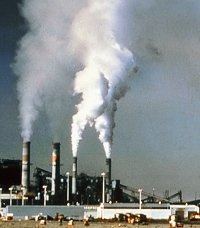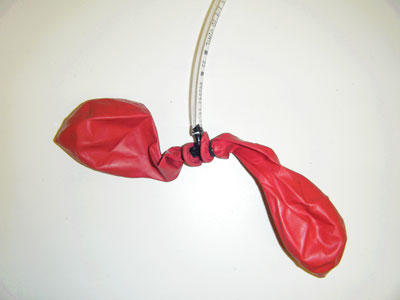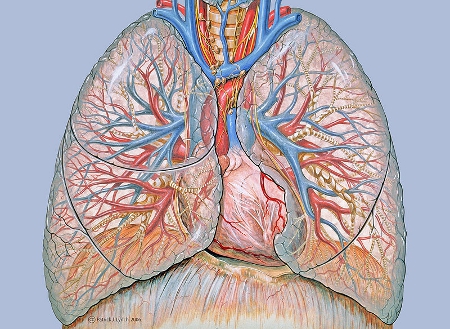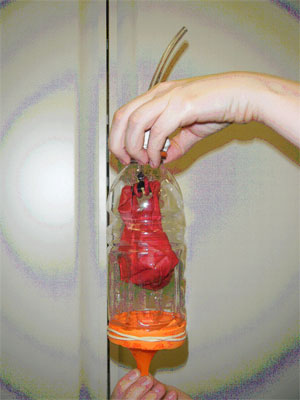Lesson: Pollution and Lung Health
 (Lesson courtesy of the California Academy of Sciences.) Level: Grades: 4 – 12.) Time required: 10 minutes preparation and 30 minutes for the activity. Download the full lesson plan pdf.
(Lesson courtesy of the California Academy of Sciences.) Level: Grades: 4 – 12.) Time required: 10 minutes preparation and 30 minutes for the activity. Download the full lesson plan pdf.
POLLUTION and LUNG HEALTH
Overview
Students will build a lung model to learn how their lungs and diaphragm work to make them breathe. The lesson features a demonstration on how incomplete combustion of fossil fuels releases particles into the air that can negatively affect human health, and how we can protect ourselves from these effects.
Objectives
Students will:
1. Build a lung model.
2. Learn how their lungs and diaphragm work to make them breathe.
3. Understand how incomplete combustion of fossil fuels releases particles into the air that can negatively affect human health.
4. Learn at least 3 things they can do to protect themselves from these effects.
California Content Standards
Grade Five
Life Sciences
2a. Students know many multicellular organisms have specialized structures to support the transport of materials.
2b. Students know how blood circulates through the heart chambers, lungs, and body and how carbon dioxide (CO2) and oxygen (O2) are exchanged in the lungs and tissues.
Grade Seven
Structure and Function in Living Systems
5b. Students know organ systems function because of the contributions of individual organs, tissues, and cells. The failure of any part can affect the entire system.
Grades Nine through Twelve
Physiology
9a. Students know how the complementary activity of major body systems provides cells with oxygen and nutrients and removes toxic waste products such as carbon dioxide.
Teacher Background
Most cell types need oxygen to survive. Microorganisms and some simple aquatic animals rely on simple diffusion of oxygen through their cell walls and tissues. However, in order for large, multicellular organisms to survive, they need a system capable of delivering oxygen from the environment to all of the cells in their bodies. For land-dwelling animals, including humans, this system is called the respiratory system. The respiratory system includes the nose, throat, trachea (windpipe), lungs, and diaphragm. This system works in concert with the cardiovascular system to transport oxygen to all tissues and expel waste products such as carbon dioxide.
Lungs contain a complex system of branching tubes. Entry of air into the lungs is controlled by a sheet of muscle located at the bottom of the rib cage called the diaphragm. When the diaphragm contracts, the chest cavity expands and this creates a vacuum that draws air into the lungs. When the diaphragm relaxes, it pushes the air back out of the lungs. When you get the hiccups, it’s because your diaphragm is contracting when it’s not supposed to.
Air enters the body through the nose or mouth, passes through the trachea and enters the lungs through one of two bronchi, the largest tubes in the lungs. The air then travels through even smaller branched tubes called bronchioles. Bronchioles end in tiny sacs called alveoli. The walls of the alveoli are only one cell thick and are covered on the outside with tiny blood vessels called capillaries. Because the walls of the alveoli and capillaries are so thin and moist, oxygen from the incoming air is able to pass from the lungs and bind to the red blood cells inside the capillaries. These oxygenated red blood cells then travel back to the heart where they are pumped out to the rest of the body.
The function of the lungs greatly depends on the organization and function of the different types of cells that make them up. The two main types of cells in the lungs are epithelial cells and goblet cells. Goblet cells produce mucus. Mucus is very important to help keep the cells in the lungs from drying out and allows the lungs to stretch when we breathe. Epithelial cells form sheets of tissue that allow oxygen to pass through. These cells also have cilia or tiny cell extensions that sweep particles, bacteria and viruses out of our lungs and spread mucus into a thin layer all over the lungs. Damage to either cell type can cause the lungs to function inefficiently.
The most common causes of lung damage are environmental toxins. These environmental toxins could be cigarette smoke, pollution, etc. When a cigarette smoker breathes in smoke from their cigarette, the toxins and tar in the smoke sticks to the insides of their lungs. This prevents the cilia on the epithelial cells from moving and trapping particles and this can lead to increased incidents of infection or lung irritation. It also allows too much mucus to build up in the lungs when the goblet cells continue to produce mucus that is no longer spread around by the cilia. This adds an additional layer that oxygen from the air must pass through to get to the capillaries and enter the blood.
Recently, it has been suggested that additional environmental toxins or airborne particles such as those produced during the incomplete combustion of fossil fuels are capable of doing similar damage in the lungs. Studies examining lung function in lifeguards who worked outside during peak commuting hours experienced a significant decrease in lung function.
Particulates are formed during the incomplete combustion of fossil fuels. Incomplete combustion occurs when the burning of fossil fuels lacks the ideal amount of oxygen. No current system that uses fossil fuels can provide the necessary amount of oxygen to completely combust hydrocarbons into the end reaction products of water and carbon dioxide. Instead, incomplete combustion of hydrocarbons produces other products including carbon monoxide, soot, and various other compounds. These byproducts can act much like cigarette smoke in the lungs and cause similar health problems. As citizens in a world that uses a large amount of fossil fuels that produce large amounts of particulate matter in the air we breathe, it is important to understand the health risks this can pose and ways to prevent them.
For more information, see “how lungs work,” from the American Lung Association.
Materials
For each student (or small group of students):
- plastic bottle (bottle suggestions: 20 oz. Gatorade bottles work best,18 or 42 oz. Sparkling mineral water and 20 oz. soda bottles work well too).
- 1 8-inch piece of ¼” plastic tubing (available at hardware stores)
- 1 Y- or T-shaped connector (available at hardware stores)
- 2 balloons
- 1 nitrile glove (or a third balloon, knotted at the bottom and cut across the widest part)
- 1 wad of playdough or other modeling clay
- several rubber bands (at least one large and two small)
- scissors
For classroom demonstration:
- 1 candle (not beeswax)
- matches or a lighter
- at least 1 clear glass or jar
Vocabulary
bronchi: the largest airway passages into the lungs
bronchioles: smaller airway passages that branch from the bronchi and end in alveoli
alveoli: small air-filled sacs at the end of bronchioles that act as the site of gas exchange
diaphragm: a thin, sheet-like muscle located at the bottom of the rib cage
incomplete combustion: the inefficient burning of fuels due to lack of oxygen that results in the production of unwanted and often harmful byproducts such as carbon monoxide or soot
soot: a black, powdery substance that consists mainly of carbon and is formed through the incomplete combustion of wood, coal, diesel oil, or other materials
particulate: a very small particle, as of dust or soot. Particulates that are given off by the burning of oil, gasoline, and other fuels can remain suspended in the atmosphere for long periods, where they are a major component of air pollution and smog.
Activity
Preparation
1. Obtain materials. Some may need to be purchased at a hardware store (tubing and connectors) or pharmacy (exam gloves).
2. You may want to “start” the cutting of plastic bottles. It will be easier for students to cut off the bottom of the bottles if there is already a starting hole to put the scissors in.
3. It will help to write out each step on the board so that if the students get lost, they will have a list of steps to follow.
Introduction
Teachers can engage students with this topic by introducing a discussion on pollution and lungs, using the background information above. More helpful information, diagrams, and simulations can be found on the National Geographic page on Lungs.
Tell your students that they will be building their own models that will explain how our lungs work. Have the students place their hands on their sides and breathe in. Explain that when we breathe in, our rib cage expands. Explain that our bodies have to create room in our chests for the air to come in. The model they will make today will show them how a muscle called the diaphragm helps create the space and draws air into our lungs.
Procedure
1. Pass out materials. (Students can work individually or in small groups.)
2. Chest Cavity: Use scissors to cut the bottom off the plastic bottle.
3. Lungs: Connect the tubing to the connector. Use the small rubber bands to attach the balloons to the other two openings on the connector. To ensure that air can flow to the balloons, be sure that your rubber bands don’t pinch the sides of the balloons together.

4. Insert the “lungs” into the chest cavity (plastic bottle) from the bottom so that the balloons are inside the bottle and the plastic tubing is sticking out from the top.
5. Use the modeling clay to create an airtight seal at the top of the bottle around the tubing.
6. Diaphragm: Stretch the exam glove (or another balloon that has been tied at the end and cut across the widest part) across the bottom of the bottle. Secure with a large rubber band to ensure an airtight seal. Be careful not to rip the glove on the bottle’s edge.
7. Students can now simulate breathing by gently pulling on the fingers of the glove. When they pull down, they should see the balloons slowly fill with air. When they push in, the air should be expelled from the balloon and it should collapse.
8. Give students some time to examine their lung models.
9. Ask the students if they think only air can enter their lungs. Try and get them to create a list of additional things which might enter their lungs along with a big breath of air (viruses, bacteria, smoke, and car exhaust).
10. Do the classroom demonstration with the candle. Light the candle and let it burn for a few seconds. Then, cover the candle with the bottom of the clear glass and let the students see the particulates that accumulate on the outside of the glass. You can do this with a few glass jars and then pass them around so that students can touch the soot if they want.
11. Ask students what the candle burning represents. It represents the burning of fossil fuels. Most candles are made with paraffin wax, which is derived from oil. It is a hydrocarbon and so burns like other hydrocarbons such as fossil fuels.
12. Explain that when anything burns, whether it is a cigarette or a car engine, particulates are released into the air and these can enter our lungs and cause health problems. (See Teacher Background for detailed information.)
Wrap-Up
Have the students brainstorm actions they could undertake themselves to protect themselves and others from particulates in the air. For example, they could check the air quality levels and air pollution forecasts; try to avoid exercising outside during peak traffic hours; bike or carpool, because fewer cars on the road means fewer emissions; not smoke cigarettes; avoid opening windows facing high traffic streets; etc. Teachers could also share stories of students who have helped improve conditions in their local communities, using the example of Siemens We Can Change the World contest winners or others.
Extensions
For a more visual example of car exhaust, tape a piece of incense to the bottom of a toy car and light it. You can then use a lung model to “breathe in” the smoke. When “breathing out,” aim the model away from the incense.
Engineering connection: Challenge older students to investigate how engineers are undertaking lung research, from working with lung tissue to creating artificial lungs. Assign a news story like this March 31, 2010 profile of a University of Iowa mechanical engineer, Ching-Long Lin, who is developing a digital lung model in order to study the interactions between pulmonary airflow, lung mechanics, and cell response.
References
- American Lung Association. Retrieved Feb. 20, 2020
- State of the Air. Retrieved Feb 20, 2020 from www.stateoftheair.org
- Lungs. Health and the Human Body. National Geographic. Retrieved Feb. 20, 2020
Learn more about California Academy of Sciences’ teacher resources and outreach programs.
Updated 2/20/2020
Filed under: Grades 6-8, Grades 9-12, Lesson Plans
Tags: Environmental science, Human Body, Pollution










